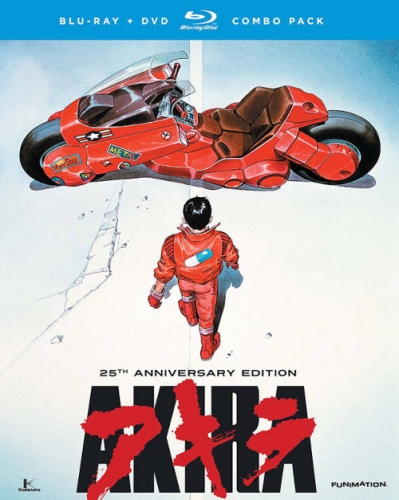Akira was certainly not the first Japanese anime to become popular on the world stage. From episodic cartoons in the 60’s and 70’s like Astro Boy, Speed Racer, and Gatchaman (aka Battle of the Planets) to the 80’s Robotech, Japanese animation had begun to make it’s way slowly into the international consciousness. However, it should be said the first anime to truly break open the genre to the success it has seen in the last few decades would be the sci-fi, cyberpunk, anime Akira.
Akira is an adaptation of director Katsuhiro Otomo’s manga series, which at the time the film was created was still being crafted. Therefore the film, while feeling like a complete entity, only tells a portion of the overall Akira story much, in the same way, Miyazaki’s Nausicaa of the Valley of the Wind would just a few scant years earlier. Of course, this closure comes at the cost of creating a very chaotic, yet layered narrative one that is still rewarding viewers after 25 years, and countless repeat viewings.
Akira takes place in Neo Tokyo, a rebuilt version of Tokyo that was built on the ashes of the old city which was destroyed in an epic explosion 30 years prior to the events of the film. The opening scene, which has to be one of the greatest opening moments in all of the animation finds us in a Road Rash style biker battle between The Capsules led by Kaneda and his best friend Tetsuo, and the Clowns as they bash it out on the highways of Neo Tokyo. As the melee draws to a conclusion, a strange-looking boy enters the roadway, and Tetsuo swerves to avoid him.
The contact between the boy, who is part of a trilogy of mutant psionics known as “Espers” and Tetsuo unleashes unforeseen powers in Tetsuo, and he is taken into government custody for experimentation, and control before his burgeoning powers can cause catastrophic damage to the those around him or the world at large. Meanwhile, his friends get interrogated by the military about the incident which gets them more curious and gets them involved with a revolutionary group. They begin to work to find out what secrets the government is hiding, and what is happening to their friend.
Honestly, that synopsis doesn’t even remotely cover the film. Akira is a film that cannot be done justice with a few sentences. It is a film that needs to be seen, then watched, again and again, to allow the intricacies of its story to unfold. A viewer can choose to view it as an awesome action-sci-fi anime and get plenty of enjoyment out of it, but there is so much detail in
the world created by Otomo that would be doing the film a disservice.
The films writing from the narrative down to various bits of deeper philosophical subtext that are intricately woven throughout the film have kept the film from aging poorly, and the animation now at 25 years of age may not be as sharp as modern animation techniques, but still looks truly stunning. Akira is a film that has been released on every conceivable format since VHS, including a Criterion LD, DVD, and an earlier now out of print Blu-ray. It is now getting it’s 2nd Blu-ray release through Funimation, a release that will hopefully keep the film in the spotlight for another generation to explore.
Funimation has brought Akira to Blu-ray in an absolutely spectacular AVC Encoded 1:85:1 1080p transfer reflecting the films original aspect ratio. The last version of Akira I personally owned was the 2001 Pioneer DVD, so I do not know how this compares to the prior Blu-ray release. That being said this release has extremely bright, and brilliant colors, excellent line detail, and quite good black levels (although they can be a tad uneven at times). There is a healthy filmic grain structure at play throughout the presentation as well.
There are 3 audio options, 2 English dubs of the film, and a 5.1 True HD mix in Japanese. As I actively avoid dubbing whenever possible I watched with the Japanese track, and was quite impressed. The dialogue, of course, through comes through clearly, but this mix was made for the sound effects, and the films now-iconic score which comes at the viewer from all sides. This is an absolutely thrilling audio track, and is just a fantastic listen. I did not detect any instances of pops, cracks, or hissing on the track.
Although quite definitive in the A/V department, there is not a huge wealth of extras supplementing the release. That being said there is enough here to certainly interest fans of the film. The most substantial extra in my view is a 29-minute interview with the film director. After that we get a 1988 archival extra on the crafting of the score for the film. Of interest to those who are fans of the film, restoration is Restoring Akira, which is 11 minutes in length and discusses the process in which Akira was restored for the 2001 DVD release. We also get The Writing on the Wall an archival extra that translates the graffiti in the film. The set is rounded off by storyboards, trailers, commercials, and a glossary for terms used in the film.
Akira is one of the most iconic, and classic Anime’s ever crafted. The Blu-ray restores it beautifully in both the audio and video department. The extras are not quite elaborate but are interesting. HIGHLY RECOMMENDED.
Director – Katsuhiro Otomo
Cast – Johnny Yong Bosch, Jan Rabson
Country of Origin – Japan
Discs – 2
Distributor – Funimation
Reviewer – Scott MAcDonald
Original Published Date – 12/03/13

